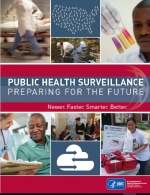Our History
As part of CDC Moving Forward, we're forming a new Office of Public Health Data, Surveillance, and Technology. Stay tuned to this website for updates.
For over 70 years, CDC has used the best available science and data to make public health decisions. Our commitment to ensuring those core tools are both timely and of the highest quality goes back just as far.
Today, the Office of Public Health Data, Surveillance, and Technology (OPHDST) leads this work. The work of OPHDST continues — and builds upon — progress made by the Deputy Director for Public Health Science and Surveillance (DDPHSS) and the Office of Public Health Scientific Services (OPHSS).

Learn more about our past work to improve surveillance and data at CDC.
Extending the Possibilities of Data and Surveillance
CDC’s expertise in science extends beyond one issue and one approach. The factors affecting our health are wide-ranging—from the impacts of a global pandemic, to inefficient or underfunded systems, to new and changing health threats, natural disasters, bio-terrorism, access to healthcare, and the growing burden of noncommunicable diseases and drug overdoses. These issues require strategic thinking, new ideas, flexibility, and readiness to connect across disciplines.[1] Having strategic CDC leadership charged with those tasks has helped drive practical approaches to address present—and anticipate future—public health challenges. It also helps ignite and incubate new initiatives and projects that are furthered by other parts of CDC and outside partners.
Why it Matters
Today’s landscape requires thinking beyond traditional approaches of collecting and sharing health information and statistics. We need accurate and timely data that direct decisions, technology that keeps pace with our need for speed, and innovation that reaches across CDC and beyond.
As the nation’s health protection agency, it is important to connect across CDC’s Centers, Institutes, and Offices (CIOs) to allow the agency to be more responsive and effective when dealing with public health concerns. Connecting and communicating CDC’s scientific priorities as a whole has been critical in finding efficiencies, leveraging resources, and tackling tough problems that need wider agency participation.
Work produced through the Deputy Director for Public Health Science and Surveillance and the Office of Public Health Scientific Services has set a strong foundation for our future focus. It has included CDC’s Data Modernization Initiative, which is ongoing into our future, as well as CDC’s Surveillance Strategy from 2014-2018.
Below are more details about our prior activities and accomplishments:
Improving Surveillance and Data Platforms
Connecting Public Health and Healthcare
Putting Data to Work
Informing New Research
References
[1] Office of the National Coordinator for Health Information Technology. Connecting health and care for the nation: a 10-year vision to achieve an interoperable health IT infrastructure. https://www.healthit.gov/sites/default/files/ONC10yearInteroperabilityConceptPaper.pdf. Accessed March 8, 2023.